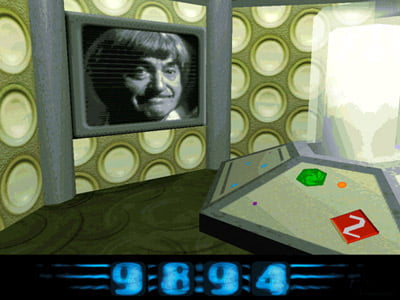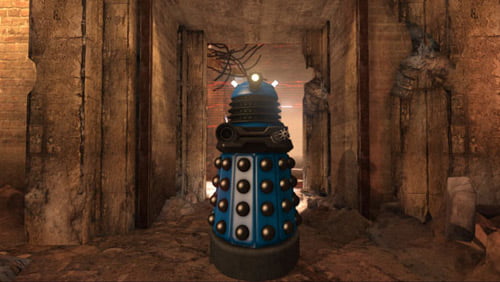Doctor Who – with its wealth of characters, companions, alien races, and timey-wimey concepts – is perfect fodder for a great video game, or so you might think.
The truth is that the Doctor Who has never sat comfortably in the world of PC and video games. There have been some notable titles, but certainly no classics. Part of this is due to the pacifist nature of the Doctor’s character, he’s not a hero suited to beat ’em ups, or shooters, and a racing game featuring Bessie or the Whomobile seems unlikely (Although don’t put anything past the Need for Speed franchise).
In the first of two articles, we take a look at the history of the Doctor’s adventures in video games. We’ll follow up with an article to consider the possibilities for future titles. We begin, appropriately enough, with:
Doctor Who: The First Adventure
1983 / BBC Micro

It’s 1983, the year of Doctor Who‘s 20th Anniversary. On screen Peter Davison is bringing a youthful exuberance to the role of the Doctor. Meanwhile, in part thanks to the BBC, computers are beginning to find their way into the nation’s homes and schools. For any British school kid of the early ’80s the BBC Mirco was ever-present, a glimpse of the future installed into a classroom. It was also home for The First Adventure, the first officially licensed Doctor Who title. The game is comprised of four mini-games that ape then current arcade hits like Space Invaders and Pac-Man. I’ve never played it, but the box art really is rather wonderful.
Doctor Who and the Warlord
1985 / BBC Micro

Doctor Who and the Warlord was also released on the BBC Micro. This text adventure featured an unspecified incarnation of the Doctor. The game is most notable for the contribution of previous Doctor Who series producer, Graham Williams. The game was released across two cassettes and featured, according to this trailer, ‘a useful save and retrieve facility’. A bit like Mass Effect 3 then.
Doctor Who and the Mines of Terror
1985 / Amstrad, BBC Micro, C64

Allegedly beginning life as a sequel to the game Castle Quest, Doctor Who and the Mines of Terror is a reasonably typical mid-80s platformer. It’s mainly notable for giving the player direct control of the Doctor for the first time. And considering the technological limitations of the time it features a remarkably recognisable version of Colin Baker’s extravagant Sixth Doctor. Oh, and there’s a new companion, a robot cat called Splinx. We can assume they didn’t have the rights to use K9.
Dalek Attack
1992 / PC, Spectrum, C64, Atari ST, Amiga

For a long time, Dalek Attack was the Doctor Who video game. In truth it was just an average 2D action platformer, but its liberal cherry picking of TV series icons, such as multiple Doctors, Ace, Daleks, Davros, Ogrons and K9, gave it a sense of authenticity missing from previous games. The game also revels in having the Dalek licence to play with, featuring versions of the evil pepper-pots from the TV series, comics and movies. As a Doctor Who fan in the early ’90s there was a distinct thrill in playing a game that could comfortably sit alongside other tie-in hits such as RoboCop and Batman.
Doctor Who: Destiny of the Doctors
1997 / PC

When this game was released in 1997, Doctor Who was stumbling through its 16 year hiatus. The Paul McGann movie had come and gone, and with it hopes for a new series. Destiny of the Doctors was highly anticipated by fans at the time, promising a return of the good old days. The signs were good, with Who actors contributing new dialogue, and FMV inserts of Anthony Ainley’s cackling version of the Master, plus it had a story written by Doctor Who legend, Terrance Dicks.
It certainly doesn’t hold up today, but in 1997 it felt so new. Being able to explore the TARDIS in three dimensions was a fan’s dream, and the discovering a Dalek or Sontaran lurking in the corridors was a magical experience, even if the controls where terrible and the performance stuttering. In truth, it was a chaotic mess, but one that the memory should treat kindly as it proved that Doctor Who just might have a place in this brave new world of digital entertainment.
Top Trumps: Doctor Who
2008/ PlayStation 2, Wii, DS

This was the first Doctor Who game in 11 years, but it wasn’t one that anyone wanted. Being kind, you might suggest that there’s a slight thrill in seeing Doctor Who characters in a video game after so long, but that’s about it. Artistically it’s quite smart, mixing the art style of The Infinite Quest animation with photographic stills from the TV show. But put simply, Top Trumps is not Magic: The Gathering. As a video game based on Doctor Who, it’s rather pointless. As a video game based on Top Trumps, it’s even more pointless.
Doctor Who: Evacuation Earth
2010/ DS

Released alongside the Nintendo Wii game Return to Earth, this was a Nintendo DS title that attempted to tap into success of the Professor Layton series. Wrapping a cerebral puzzle game around the Doctor Who licence feels like an obvious approach, and expectations were firmly set at reasonable. Alas, whereas the Layton games have style in execution, and substance in game-play, Evacuation Earth has neither.
Mechanically, the game often feels broken, with a terrible interface and an abundance of technical glitches. And like its Wii brethren, the game does nothing to evoke the series that spawned it. Compared to Professor Layton and the Curious Village it’s telling that Evacuation Earth is the game that feels least like Doctor Who.
Doctor Who: Return to Earth
2010 / Wii

The Doctor’s Sonic Screwdriver. The Wii Remote. A match made in heaven, right? Unfortunately not. Return to Earth is without doubt the worst Doctor Who game in recent years. It’s an incredibly tedious third-person adventure that consists of little more than A-to-B fetch quests, and some hilariously clumsy stealth sections.
If it wasn’t boring enough to play, it looks also looks terrible, with muddy textures and tepid design that captures none of the excitement and energy of the TV show. It sounds a little better, using sound clips from Murray Gold’s excellent TV score, plus some OK vocal work from the series cast, but all in all this is one to avoid.
That said, the Sonic Screwdriver Wii Remote is actually rather terrific.
Doctor Who: The Mazes of Time
2010 / iOS, Android

For the first time in a long time we have a Doctor Who game that is actually competent. Featuring Matt Smith’s 11th Doctor, and companion Amy Pond, the action takes place across a series of puzzle rooms set in a variety of galactic locations. There’s even a paper-thin plot that just about manages to get away with bringing together the Daleks, Cybermen and Silurians without causing too many headaches. That’s Time Engines for you.
There are some good puzzling moments, and the use of multiple characters works well. Productions values are also pretty good, but the game occasionally comes undone by its fiddly virtual joystick. A DS or 3DS version would have been appreciated. The Mazes of Time is still available and worth a look.
Doctor Who: The Adventure Games
2010-2011 / Mac, PC

Well, here’s something unexpected. A series of games produced in close collaboration with the BBC, using real writers, made by a developer with a decent pedigree, and with the involvement of Broken Sword creator, Charles Cecil. After the Wii and DS debacles it’s as if the BBC decided that enough was enough. This is a genuine attempt to craft a series of games that are true to series, well produced, and enjoyable to play. And do you know what? They pretty much succeed. And they are free. Thank you BBC.
City of the Daleks and Shadows of the Vashta Nerada are the pick of the bunch, both balancing stealthy exploratory game-play with simple but fun mini-games. Add in plenty of fan-friendly collectibles, and you have a finally have a top-tier Doctor Who game. Although they are not graphically high-end, they do feature well designed environments that are far beyond the scope of the TV series. The Dalek city of Kaalann is particularly impressive, as is the voice work from series regulars Matt Smith, and Karen Gillan.
These adventures are fairly short, but taken as a whole – and considering they are free – it’s hard not to be impressed.
Doctor Who: Worlds in Time
2012 / Browser, Flash

Worlds in Time is a social MMORPG in which you accompany the Doctor on a series of adventures and side-quests. The core game-play is best described as an RPG lite, with most missions being an excuse to play Doctor Who versions of popular puzzle games, such as Tetris or Pipe-Dream.
The game is squarely aimed at kids, but no worse for it. Becoming one of the Doctor’s companions is a kid’s dream come true, and it’s delightfully done here. The writing and production values are exemplary, with the chunky, drawn art style and excellent music making the game pop beautifully. The crafting and customisation features are also smartly implemented, and for a social game it’s remarkably generous with its pay-gateing. Keep your credit card hidden from the kids and there’s a lot of fun to be had.
Doctor Who: The Eternity Clock
2012 / PS3, PSVita, PC

The Eternity Clock has many problems, but let’s start with what it gets right. For a start, it actually feels like Doctor Who. The music (again, Murray Gold) is well used, the voice acting is spot on, and the script is full of authentic one liners and funny Doctorisms. Graphically it’s fine, and the animation, although fairly rudimentary, captures Matt Smith’s awkward gait very well.
The game also has plenty of exciting moments, whether it’s avoiding patrols of Cybermen in the sewers beneath London, or outwitting the Daleks in the bombed-out ruins above. Heck, the game even plays around with some basic time-travel gimmicks, with your actions in one time zone affecting the environments of another.
So it’s a shame that all this love and detail is wrapped around a diet-light Metroidvania platformer. It’s more than passable, but there is little ingenuity to be found. However, for hard-core fans this is pretty enjoyable stuff and one of the better Doctor Who games.
–
What should a Doctor Who game be like? We take a look at what it takes to make a good Doctor Who video game?







The doctor was way ahead of his time 🙂